

L'Allemagne reste exportatrice d'électricité malgré son retrait du nucléaire. L'Allemagne reste exportatrice d'électricité malgré son retrait du nucléaire BERLIN - L'Allemagne est restée exportatrice d'électricité, en dépit de sa transition énergétique qui prévoit l'abandon du nucléaire d'ici 2022 et la promotion des énergies renouvelables, selon ses données publiées mardi par l'Office fédéral des statistiques (Destatis).
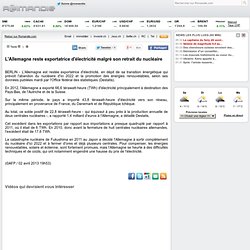
En 2012, l'Allemagne a exporté 66,6 térawatt-heure (TWh) d'électricité principalement à destination des Pays-Bas, de l'Autriche et de la Suisse. Sur la même période, le pays a importé 43,8 térawatt-heure d'électricité vers son réseau, principalement en provenance de France, du Danemark et de République tchèque. Chernobyl and Fukushima: Ukraine’s Lessons for Japan. Pripyat, UKRAINE - Driving the bleak road from Chernobyl’s exclusion zone back to Kiev 25 years after that nuclear disaster, it struck me that this tragedy must have had a double impact on the people who lived here.
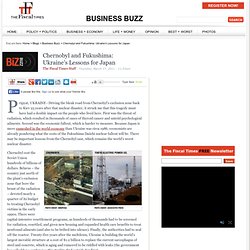
First was the threat of radiation, which resulted in thousands of cases of thyroid cancer and untold psychological ailments. Second was the economic fallout, which is harder to measure. Because Japan is more enmeshed in the world economy than Ukraine was circa 1986, economists are already pondering what the costs of the Fukushima Daiichi nuclear fallout will be. There may be important lessons from the Chernobyl case, which remains the world’s worst nuclear disaster. Japon: un déficit commercial historique lié au yen et à Fukushima. Tokyo (AFP) - Le Japon a enregistré en août un déficit commercial historique de 7,4 milliards d'euros, gonflé par la dépréciation du yen et la nouvelle soif d'hydrocarbures entraînée par l'accident nucléaire de Fukushima.
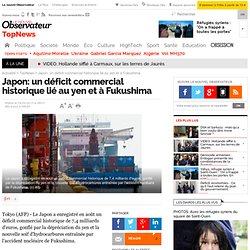
Ce déséquilibre des comptes de la balance commerciale de la troisième puissance économique mondiale s'est aggravé de 25% sur un an, a annoncé jeudi le ministère des Finances, à 960 milliards de yens (7,4 milliards d'euros). Jamais l'archipel n'avait subi un trou aussi colossal au mois d'août depuis le lancement de cette statistique sous cette forme il y a 35 ans.
Il s'agit du 14e mois consécutif de déficit de la balance commerciale d'un pays autrefois habitué à des excédents soutenus par la puissance de ses industries exportatrices (électronique, automobile, etc). More Nuclear Refugees Sue Tepco. United front: Plaintiffs suing Tokyo Electric Power Co. over the Fukushima nuclear accident that forced them to seek refuge in the Kansai region hold a banner Tuesday outside the Osaka District Court emphasizing their desire to return to ‘normal life.’ | KYODO More Japanese nuclear refugees sue Tepco, government Japan Times OSAKA – A total of 171 people from Fukushima Prefecture who had to flee their homes because of the crisis at the Fukushima No. 1 nuclear plant sued Tokyo Electric Power Co. and the central government Tuesday for ¥1.62 billion in damages.
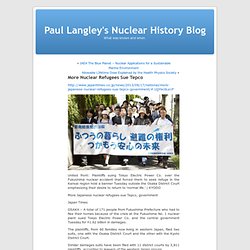
The plaintiffs, from 60 families now living in western Japan, filed two suits, one with the Osaka District Court and the other with the Kyoto District Court. Similar damages suits have been filed with 11 district courts by 3,811 plaintiffs, according to lawyers of the western Japan groups. Radioactivity in the jet stream. The Geophysical Institute at Fukushima University measured gamma and beta radiation at increasing altitude in April through August, 2011.

They used a radiosonde (weather balloon) with a radiation measuring device on it to obtain the readings. The first image is from April 2011, and shows increased beta readings at an altitude of 7-8 km. This is below the level of the jet stream. Fukushima: An Assessment of the Quake, Tsunami and Nuclear Meltdown. 3:11 – The What It is just over two years since Japan’s quake, tsunami, and nuclear meltdown.
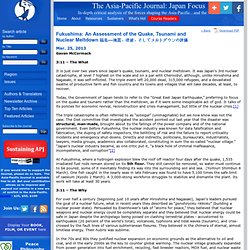
It was Japan’s 3rd nuclear catastrophe, at level 7 highest on the scale and on a par with Chernobyl, although, unlike Hiroshima and Nagasaki, it was self-inflicted. The triple event left 20,000 dead, 315,000 refugees, and a devastated swathe of productive farm and fish country and its towns and villages that will take decades, at least, to recover. At Fukushima, where a hydrogen explosion blew the roof off reactor four days after the quake, 1,535 irradiated fuel rods remain stored on its 5th floor. They still cannot be removed, so water must continue to be poured, some of it inevitably finding its way into the surrounding soil and sea. Japanese reaction to Fukushima Daiichi nuclear disaster. Japan towns, villages, and cities around the Daiichi nuclear plant.
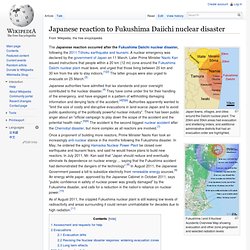
The 20km and 30km areas had evacuation and sheltering orders, and additional administrative districts that had an evacuation order are highlighted. Death rates spike among elderly evacuees from Fukushima. Former residents of nursing homes near the Fukushima No. 1 nuclear plant died at a higher rate than usual in 2011, a study has shown, likely because of the stress of evacuation and having to live in temporary accommodations such as draughty school gyms.

Researchers from the Fukushima Medical University studied reports submitted to the Fukushima prefectural government by 34 institutions for the elderly and found that the death rate over eight months in 2011 was 2.4 times that of the same period in 2010. Furthermore, there was a spike in deaths during the three months immediately following the disaster to three times the level of a year earlier. The Fukushima Collective Evacuation Trial: Infant mortality in Japan after Fukushima. Leuren Moret: 100,000 excess deaths in 2011 in North America from Fukushima radiation.
US sailors sue Tokyo Electric Power Co. over radiation exposure. Please support our site by enabling javascript to view ads.
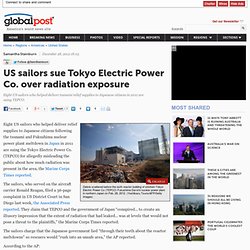
Eight US sailors who helped deliver relief supplies to Japanese citizens following the tsunami and Fukushima nuclear power plant meltdown in Japan in 2011 are suing the Tokyo Electric Power Co. (TEPCO) for allegedly misleading the public about how much radiation was present in the area, the Marine Corps Times reported. The sailors, who served on the aircraft carrier Ronald Reagan, filed a 36-page complaint in US District Court in San Diego last week, the Associated Press reported. Un parti antinucléaire voit le jour au Japon.
Mutations chromosomiques (plantes) Mutations des insectes. The Fish of Fukushima. On June 4th, 2013, London-based news source the Guardian reported, “Fukushima tuna safe to eat – study.”
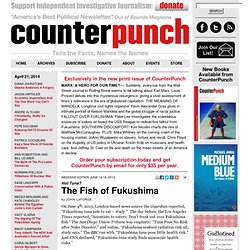
The day before, the Los Angeles Times reported, “Scientists to eaters: Don’t freak out over Fukushima fish.” The San Diego Union-Tribune was emphatic: “Tuna Pose No Risk after Nuke Disaster,” and online, “Fukushima seafood radiation risk nil, study says.” The BBC ran with, “Fukushima tuna pose little health risk.” And CNN declared, “Fukushima tuna study finds minuscule health risks.” Abundance of birds in Fukushima as judged from Chernobyl. Abstract The effects of radiation on abundance of common birds in Fukushima can be assessed from the effects of radiation in Chernobyl. Abundance of birds was negatively related to radiation, with a significant difference between Fukushima and Chernobyl. Analysis of 14 species common to the two areas revealed a negative effect of radiation on abundance, differing between areas and species. RADIOACTIVITE LES VIRUS MUTANTS FRAPPENT LE JAPON.
Fukushima Watch: The Riddle of the Radioactive Fish - Japan Real Time. Agricultural Implications of the Fukushima Nuclear Accident. The World Today - Fukushima rice crop grown in Queensland 24/05/2012. ELEANOR HALL: The successful harvest of a small plot of rice in North Queensland is raising the hopes of some of Japan's nuclear affected farmers. The harvest is part of a trial backed by the Townsville Sister City forum and the Queensland Government to grow traditional Japanese rice to export to farmers in Japan whose land is so contaminated that it won't support edible crops for centuries. Charlie McKillop reports from the Burdekin. (Sound of rice being harvested) Fukushima nuclear plant: Toxic isotope found in groundwater. 19 June 2013Last updated at 05:32 ET Radioactive water was found to be leaking from a storage tank at the plant last month High levels of a toxic radioactive isotope have been found in groundwater at Japan's Fukushima nuclear plant, its operator says.
Tokyo Electric Power Company (Tepco) said tests showed Strontium-90 was present at 30 times the legal rate. The radioactive isotope tritium has also been detected at elevated levels. The plant, crippled by the 2011 earthquake and tsunami, has recently seen a series of water leaks and power failures. The tsunami knocked out cooling systems to the reactors, which melted down. Protect the children of Fukushima against radiation exposure 福島の子供を守れ. (1) Facebook. A Fukushima, «on ne maîtrise rien», témoigne Corinne Lepage. Elle a «pris son baluchon» et elle s’est rendue sur les lieux de la catastrophe. La députée européenne Corinne Lepage, qui suit particulièrement la question du nucléaire au Parlement européen, s’est rendue au Japon du 29 août au 2 septembre pour y rencontrer les autorités, les ONG et les associations de familles de Fukushima. Elle en revient avec des nouvelles alarmantes sur l’état de la centrale accidentée et la radioactivité à laquelle sont confrontées les populations, mais témoigne également de la possibilité d’adapter la consommation électrique d’un pays à de nouvelles contraintes et dénonce l’industrie nucléaire, incapable de faire face aux accidents dont elle est à l’origine.
Le blog de Fukushima. Fukushima farming wrecked by nuclear power. The upshot of Ralph Lapp’s 1970s advocacy of placing nuclear power plants far from cities, for, he said, their cooling systems were to vulnerable and subject to damage, presenting the risk of overheating and the release of huge amounts of radio-chemical poisons over wide areas of densely populated areas.
Better he said, to have NPPs as far from these areas as possible. In Japan, that still places them in reach of Tokyo, and in fact in the middle of Japan’s food bowl. One can see its better to make a few suffer rather than many, but where is the moral basis for such suffering? People such as NPP advocate Lapp (AEC) may have been anti bomb, but he was pro NPP. Japan Flocks To Solar Homes In Fukushima Fallout. March 11th marked the one year anniversary of the tragic earthquake and tsunami that devastated Japan, and triggered a catastrophic meltdown at the Fukushima Dai-ichi nuclear power plant.
As Japan tries to pick up the pieces from that disaster, its government has made very definite decisions to shift the country away from a reliance on nuclear power, and citizens have followed suit. Instead of slapping together housing as quickly as during the weeks of power shortages that followed, Japanese developers chose to focus on building styles that would help the country remain operational should a similar disaster occur again. Several development companies began work on “green” apartments equipped with solar panels, and the buildings are already selling out. Each apartment’s solar system comes with control panels and a display that compares energy generation and use on a month-to-month and year-to-year basis, according to the New York Times.
Related Reading: The Death of a Farm in Iitate – One year later. Even by the heart wrenching standards of the March 11 disaster, Hiroshi Sano and his neighbours can count themselves among the unluckiest of survivors. For an entire month, no one told the people of Iitate – a village which lies about 20 km outside of the exclusion zone around the Fukushima nuclear plant – that they were in a so-called “hot spot”.
(Paul’s note: Greenpeace picked up the hot spot early, but their urgent report was ignored then contested by the Japanese government). Radiation levels in Iitate were – and still – are as high as many areas within the zone, so by the time they were eventually told to leave they’d been dangerously exposed.
Dégâts naturels : quels risques pour la centrale de Fukushima. La centrale nucléaire de Fukushima daï-ichi est devenue un énorme déchet nucléaire à ciel ouvert. L’eau est le principal ennemi des déchets radioactifs. L’Andra l’a appris à ses dépens au centre de stockage de la Manche : les déchets entreposés en plein air pendant des années ont pris l’eau, qui est devenu radioactive et a contaminé durablement les nappes phréatiques. Japon: L'agence de l'énergie atomique va ouvrir un bureau à Fukushima - News Monde: Asie & Océanie. Hooked on Nuclear Power: Japanese State-Local Relations and the Vicious Cycle of Nuclear Dependence 原子力に繋ぎとめられて−−国対地方の関係と原子力依存の悪循環. Hooked on Nuclear Power: Japanese State-Local Relations and the Vicious Cycle of Nuclear Dependence Hiroshi Onitsuka Abstract This article examines the problems associated with the fact that Japanese nuclear power plants have multiple reactors within one plant and are concentrated in specific regions.
It analyzes the situation from international, domestic, and local perspectives, revealing features of Japanese state-local relations.
India does not need nuclear energy: Top scientist.